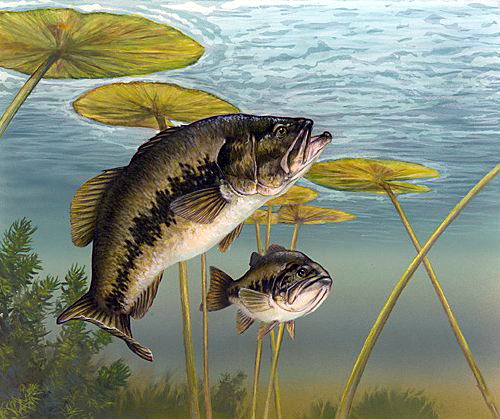Largemouth Bass (Micropterus salmoides) - Wiki Largemouth bass
From Wikipedia, the free encyclopedia
[Photo] Micropterus salmoides from U.S. Fish and Wildlife Service. Date 31-Jul-2006. Author Timothy Knepp
The Largemouth bass (Micropterus salmoides) is a species of fish. Also known as Black Bass, Green Trout, Bigmouth Bass, and Lineside Bass. The largemouth bass is in fact, not a bass. It is instead a member of the Sunfish family. The name comes from its resemblance to members of the temperate bass family, which includes the striped bass.
Physical Description
The largemouth bass is marked by a series of dark blotches forming a jagged horizontal stripe along the length of each side. It can also be totally black. The upper jaw of a largemouth bass extends beyond the back of the eye. The average bass weighs 1 to 3 pounds and measures between 12 and 18 inches long.The largest of the black basses, the Largemouth has reached a maximum recorded overall length of 97 cm (38 in), and a maximum recorded weight of 22 lb, 4 oz (10 kg, 113 g). It can live as long as 23 years, and, along with the black crappie, is also known as the Oswego bass.
Forage
The largemouth bass's diet changes as it matures, consuming mostly small food items such as plankton and insects as juveniles. As adults their eating habits mature to include small fish, crayfish, and frogs. Largemouth bass have even been known to take small mammals such as mice, rats and small birds. Under the cover of grass, brush, or drop-offs, the largemouth bass will use its sense of smell, sight, and hearing to attack and seize their prey.
Reproduction
Largemouth spawn in shallow lakes and ponds in the spring, when the water temperatures reach about 64° F and some spawn in 70 to 74 degrees. Most people have found that the larger fish spawn first and in deeper water. Females can lay up to a million eggs during each season in a shallow depression that the male forms in the ground. The male will then guard the eggs and fry, driving away any predators that come too close to the nest site.
Senses
Lateral Line: The Lateral Line is a series of pores located alongside the bass. This set of pores are used to detect vibrations in the water. These pores are sensitive enough to detect the speed, size, and shape of other fish.
Sight: Largemouth bass have very good color vision and they mostly use their sight in clear water. In fact, depending on water clarity, largemouth bass can see anywhere from 100 feet to 5 feet.
Hearing: Bass have ears located inside of their skull. However, because sound travels through water much better than air a bass has a very keen sense of hearing, which it uses to detect the presence of possible predators or prey.
Smell: Bass use their strong sense of smell to collect information about their surroundings, including potential prey or predators. If they smell a predator nearby, they will usually swim away from the area.
http://en.wikipedia.org/wiki/Largemouth_bass
| The text in this page is based on the copyrighted Wikipedia article shown in above URL. It is used under the GNU Free Documentation License. You may redistribute it, verbatim or modified, providing that you comply with the terms of the GFDL. |
